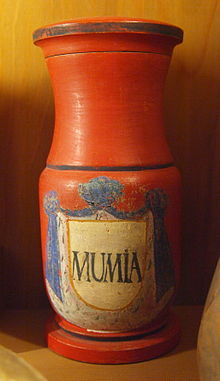



Mummia, mumia, or originally mummy referred to several different preparations in the history of medicine, from "mineral pitch" to "powdered human mummies". It originated from Arabic mūmiyā "a type of resinous bitumen found in Western Asia and used curatively" in traditional Islamic medicine, which was translated as pissasphaltus (from "pitch" and "asphalt") in ancient Greek medicine. In medieval European medicine, mūmiyā "bitumen" was transliterated into Latin as mumia meaning both "a bituminous medicine from Persia" and "mummy". Merchants in apothecaries dispensed expensive mummia bitumen, which was thought to be an effective cure-all for many ailments. It was also used as an aphrodisiac.[1]
Beginning around the 12th century when supplies of imported natural bitumen ran short, mummia was misinterpreted as "mummy", and the word's meaning expanded to "a black resinous exudate scraped out from embalmed Egyptian mummies". This began a period of lucrative trade between Egypt and Europe, and suppliers substituted rare mummia exudate with entire mummies, either embalmed or desiccated. After Egypt banned the shipment of mummia in the 16th century, unscrupulous European apothecaries began to sell fraudulent mummia prepared by embalming and desiccating fresh corpses.
During the Renaissance, scholars proved that translating bituminous mummia as mummy was a mistake, and physicians stopped prescribing the ineffective drug. Artists in the 17–19th centuries still used ground up mummies to tint a popular oil-paint called mummy brown.
- ^ Ana, Ruiz (2001). The Sprit of Ancient Egypt. Agora Publishing. ISBN 9781892941497.